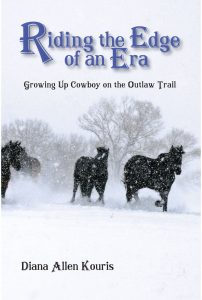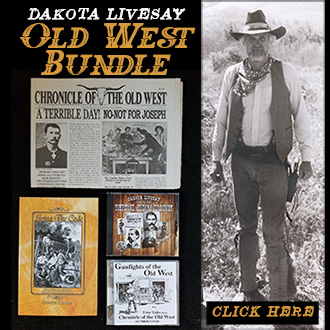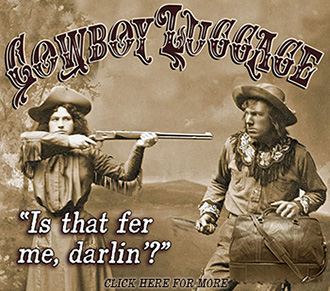 Riding the Edge of an Era; Growing up Cowboy on the Outlaw Trail, Diana Allen Kouris, High Plains Press (800) 552-7819, $17.95, Paperback.
Riding the Edge of an Era; Growing up Cowboy on the Outlaw Trail, Diana Allen Kouris, High Plains Press (800) 552-7819, $17.95, Paperback.
High mountain trails deep with snow, ice storms and hail, bone-chilling wind mingled with the faraway cries of wily coyotes fill the pages of this real-life adventure. Carefully written from beginning to end by a lady whose family spans several generations of ranchers, the setting is Butch Cassidy country where Utah, Wyoming, and Colorado meet. From the writer’s earliest days, there was a no-nonsense approach to life where one mis-step could lead to serious injury and even death. The family consisted of parents and six children; a cowboy father, and a mother who could ride and rope as easily as rustle up Christmas dinner.
There was no TV or electricity, but the kids had many horses and memorable days filled with everything from hummingbirds to snowflakes. Picnics, swimming, and favorite pets are remembered, including a pony named Comet whose favorite sport was scraping his riders off under trees. Long trail drives, wild horse roundups, killer storms, and the learning of independence, the children grew into teenagers, and eventually adults. The reader grieves when a favorite horse is found dead where he fell in the mountains, and when another struggles in vain against fever, leaving his heart-broken young owner to mourn over the carrion remains. When the seven-year-old sister is crushed under the back wheels of a farm truck, and when at the end of the story the brave mother dies of cancer, and a favorite brother is lost in an accident, you will close the last page with a lump in your throat and tears in your eyes.
The author has captured real ranch life as it existed in the days between the old and new West, before battles between ranch families and the government’s Bureau of Land Management. Eventually the land is lost to Uncle Sam for a recreation area, and the family must make profound decisions.
Along the way, the author rides past crumbling cabins and deserted home sites where historic murders took place, and bodies were found. Most crimes were never solved due to a lack of enough lawmen in territories too sparsely populated for a sheriff to be interested. People faced life as it came at them on a daily basis. They were tough and independent, they solved their own problems, they never asked for a handout.
Filled with photographs complimenting the text, we see Nonie and Diana, Bob and Marie and Bill Allen and the others in the story as they grin back at camera lenses. The author writes with a sharp eye for detail and never misses describing scenes of “candy colored cactus flowers,” or “nighthawks darting overhead in evening coolness.” There is love, devotion, loyalty, sacrifice, and through it all, the powerful bond existed between Marie and Bill Allen, and their children. There were no crybabies here. If you fell off your horse, bloodied your knee, bumped your head or fell into the creek, you learned to laugh about it. This book is not about fluffy toy animals on Sesame Street or even fairness. It’s about surviving the elements, self-sufficiency and courage. It’s about cold winter cabins deprived of hot water, indoor plumbing or electric light. It’s about doing laundry by hand, milking a cow, and stacking hay during school vacations. It’s about Diana Allen, the smallest of the children helping drive a herd of cattle in a snowstorm when she was only 6 years old.
This highly memorable book reminds us of what good writing is about, how important original detail is to the text, and in the age of hard to find good stories, we can be grateful some wise storytellers still exist. This book is almost breathtaking in its sincerity; a most memorable read.
Editor’s Note: The Reviewer, Phyllis Morreale-de la Garza is the author of many published books, including Silk and Sagebrush: Women of the Old West, published by Silk Label Books, P.O. Box 700, Unionville, New York 10988 (845-726-3434) www.silklabelbooks.com
*Courtesy of Chronicle of the Old West newspaper, for more click HERE.
 In 1869 the Kiowa and the Comanche were being relocated to a reservation near Fort Sill, Oklahoma. President Grant felt if Quakers were hired as Indian Agents, they would be able to teach the Indians to be pacifists. So, Lawrie Tatum, a man known for his Quaker work, was appointed to the unenviable job as the Kiowa-Comanche agent.
In 1869 the Kiowa and the Comanche were being relocated to a reservation near Fort Sill, Oklahoma. President Grant felt if Quakers were hired as Indian Agents, they would be able to teach the Indians to be pacifists. So, Lawrie Tatum, a man known for his Quaker work, was appointed to the unenviable job as the Kiowa-Comanche agent.  In 1869 the Kiowa and the Comanche were being relocated to a reservation near Fort Sill, Oklahoma. President Grant felt if Quakers were hired as Indian Agents, they would be able to teach the Indians to be pacifists. So, Lawrie Tatum, a man known for his Quaker work, was appointed to the unenviable job as the Kiowa-Comanche agent.
In 1869 the Kiowa and the Comanche were being relocated to a reservation near Fort Sill, Oklahoma. President Grant felt if Quakers were hired as Indian Agents, they would be able to teach the Indians to be pacifists. So, Lawrie Tatum, a man known for his Quaker work, was appointed to the unenviable job as the Kiowa-Comanche agent. 
 Riding the Edge of an Era; Growing up Cowboy on the Outlaw Trail, Diana Allen Kouris, High Plains Press (800) 552-7819, $17.95, Paperback.
Riding the Edge of an Era; Growing up Cowboy on the Outlaw Trail, Diana Allen Kouris, High Plains Press (800) 552-7819, $17.95, Paperback. The stories of the bravery of the
The stories of the bravery of the 
 With the completion of the
With the completion of the 



